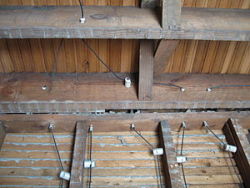 The Santa Rosa area has plenty of historic neighborhoods full of charming antique houses. However, sometimes antique homes feature severely antiquated technology. So, what do you do if the Greek Revival house you’ve fallen in love with turns out to have knob and tube wiring?
The Santa Rosa area has plenty of historic neighborhoods full of charming antique houses. However, sometimes antique homes feature severely antiquated technology. So, what do you do if the Greek Revival house you’ve fallen in love with turns out to have knob and tube wiring?
The short answer: know what to expect, be prepared for updates and upgrades, and factor the costs into your purchase price.
If you’re making a decision on buying a house with knob and tube wiring, read on to understand why knob and tube isn’t all bad — but why you will likely face some challenges that a residential electrician can help you overcome.
A Short History of Knob and Tube Wiring
For houses built in the 1930s or earlier, knob and tube wiring was the norm. Knob and tube worked back then, and it still functions today for a small amount of energy consumption.
The ”knob and tube” name refers to the fact that these wiring systems use basic copper wires with porcelain knobs and tubes as support and insulation.
Modern systems eventually became cheaper to install and easier to maintain. Today, electrical codes make it illegal to install new knob and tube systems in residential homes.
For the purposes of electrical inspection, financing, and homeowners insurance, most home buyers will elect to replace most or all knob and tube wiring with modern options.
Why Knob and Tube Wiring Poses Risks
Life was very different when knob and tube wiring was commonplace. People used far less electricity. Wiring systems did not yet feature grounding. Builders and electricians simply could not foresee all the changes that have taken place.
While knob and tube wires can safely transport electrical current within their designed capacity, the systems have generally eroded and been damaged over the past century. As a home buyer, you have to worry about errors and accidents that have occurred over the many decades since the wiring was installed.
Potential dangers of knob and tube wiring include:
- Knob and tube wiring that cannot handle modern electrical loads.
- Previous owners may have unwisely replaced fuses with higher-capacity fuses that go beyond the wiring system’s capacity.
- Cotton and other insulation may still be present and posing a fire hazard.
- Wiring is likely exposed, sagging, and damaged in places.
- Age and damage add up to make knob and tube wiring more likely to cause damage and fires.
Mortgages and Insurance Polices with Knob and Tube Wiring
You may be perfectly content to live with knob and tube wiring, but the other stakeholders of your home are probably going to insist that you change it.
Many financing and insurance companies decline to work with knob and tube homes or have strict requirements for updating the wiring. When you are shopping for the best rates and best policies, you don’t want to limit yourself to a few companies. Better to make the recommended upgrades that will reduce your risk of fire, property damage, personal injury, and future repairs.
An electrician can work with you to meet the requirements of mortgage companies and insurers. Preserving the historic aspects of the home while upgrading to safe and sound modern electrical wiring can be done.
Consult with an Electrician When Buying a Home with Knob and Tube Wiring
If you’re looking at an antique Santa Rosa home with knob and tube wiring, talk to an electrician before putting in an offer. The costs and timeline of electrical upgrades should be factored into your purchasing decision so that you don’t end up getting burned — figuratively and literally.

